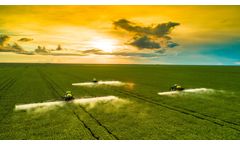Agriculture Sensor Articles & Analysis
15 articles found
Abstract: With the rapid development of precision agriculture, the application of smart soil sensors has become an important part of modern agricultural production. ...
These sensors are essential in a wide range of industries, from agriculture to manufacturing, where evaporation plays a crucial role in determining the quality and quantity of the final product. ...
Summary: With the development of intelligent agriculture in the Internet of things, many agricultural sensors appear in agricultural environmental monitoring, among which illumination sensor is a more important one.The sensor measures the intensity of light, which affects photosynthesis and, in ...
Usually used with different soil sensors, such as soil moisture sensor, soil temperature and humidity sensor, soil three-in-one sensor, soil nitrogen, phosphorus and potassium sensor, soil ph sensor or multi-depth soil hygrometer. ...
Under the 2008 Climate Change Act, the agriculture industry has pledged to reduce greenhouse gas emissions by 11% by 2022. ...
In this series of articles, we bring you the journey of your food, from farm to fork, highlighting the agricultural sensors used along the way. Edinburgh Sensors products can be used in virtually every step of the food chain in order to ensure the quality and safety of the final food product. ...
Therefore, it is very important to use carbon dioxide sensors to monitor the CO2 concentration in the greenhouse. At present, the most commonly used carbon dioxide sensor works based on NDIR non-dispersive infrared technology.Where is the greenhouse carbon dioxide sensor installed? ...
Types Of Smart Sensors For Agriculture Rapid social development, climate change, reduced rainfall and increased demand for food have all had a big impact on agriculture. ...
Therefore, it is very important to use carbon dioxide sensors to monitor the CO2 concentration in the greenhouse. At present, the most commonly used carbon dioxide sensor works based on NDIR non-dispersive infrared technology.Where is the greenhouse carbon dioxide sensor installed? ...
Agriculture in the UK is responsible for 9% of total greenhouse gas emissions, with that number rising to 30% of worldwide total emissions.1 There are a variety of sources for such gases in agriculture, including methane production from livestock, carbon dioxide release on soil disturbance, and emissions from farm machinery.2-4 The question is how to reduce such emissions. Under the 2008 Climate ...
Back in the 1980’s, brothers Mike, Gregg and Don Tvetene were working at their family-owned Tvetene Turf Farms in Billings, Montana. The business was faced with a critical labor shortage at the same time that it was experiencing huge demand for their turf. Out of necessity, the brothers conceived of an automatic turf harvester that could cut and stack sod using just one operator. Their ...
In this series of articles, we bring you the journey of your food, from farm to fork, highlighting the agricultural sensors used along the way. Edinburgh Sensors products can be used in virtually every step of the food chain in order to ensure the quality and safety of the final food product. ...
I listened as the presenter detailed why gathering agriculturally useful data with scouting drones can be difficult and fraught with frustration. ...
At Sentera, it is our mission to provide you only the most valuable crop health data, which is why all of our agricultural drone sensors produce TrueNDVI output. It’s important to understand how these products are different before deciding which technology makes sense for your business. ...
The Omni naturally partners with a gimbaled Sentera Double 4K Sensor, creating an easy-to-use, precise drone package for the Inspection, Survey and Mapping, and Agriculture industries. ...






